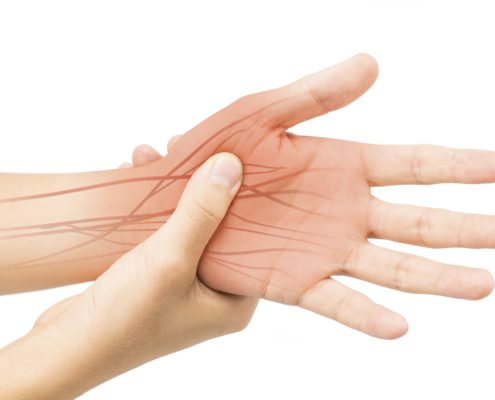Reflect Sympathetic Dystrophy
Complex regional pain syndrome (CRPS) is a chronic pain condition that can affect any area of the body, but often affects an arm or a leg. It is generally pretty uncommon and usually develops after surgery, stroke, injury, or heart attack.
Symptoms of RSD
Most symptoms of CRPS are the same between each person, though the duration of the pain can differ from person to person. The most common beginning symptoms that most people experience are swelling, redness, pain, hypersensitivity, and changes in temperature. Other symptoms include:

Reflect Sympathetic Dystrophy
- Non-stop burning or throbbing pain usually located in leg, foot, arm, or hand
- Touch or cold sensitivity
- Swelling in the most painful area
- Joint stiffness
- Movement of the affected body part is decreased
- Skin texture changes- skin may become thin and shiny or tender
- Muscle weakness and spasms
- Skin color changes- red or blue to white and mottled
- Skin temperature changes- sometimes sweaty skin other times cold
- Hair and nail growth changes
Sometimes, CRPS can spread from the original source to other parts of the body, and at this point the syndrome is irreversible. If symptoms are caught early, treatment may reverse CRPS.
Causes of RSD
Doctors categorize complex regional pain syndrome in two types. Both of these have similar symptoms, but different causes:
- Type 1: This is commonly known as reflex sympathetic dystrophy syndrome, which occurs following an injury or an illness that didn’t directly damage the nerves in the affected limb. Roughly 90% of people with CRPS have type 1.
- Type 2: This type happens after a distinct nerve injury takes place.
A crushing injury, amputation, fracture, or a forceful trauma to a leg or arm often causes CRPS. There can be other causes such as heart attacks, infections, and surgeries.
Diagnosis and Treatment of CRPS
A physical exam and medical history are commonly the only two things that can diagnose complex regional pain syndrome. There’s no exact test that can diagnose CRPS, but certain tests may contribute to the diagnosis:
- Bone scan: A procedure that can detect changes within the bone by injecting a radioactive substance into a vein that will permit a better sight of your bones with a special camera
- Sympathetic nervous system tests: Tests that check for disturbances within your sympathetic nervous system.
- X-rays: If you are in the later stages of the disease, x-rays can check for loss of minerals within the bones.
- MRI: Imaging that shows tissue damage or changes.
Diagnosing CRPS can be a process of elimination. Your doctor will not want to diagnose you with CRPS if he/she thinks there may be something else going on. All other diseases and/illnesses need to be ruled out.
It is important to seek medical attention promptly if you are experiencing complex regional pain syndrome symptoms because the disease can be greatly improved or even reversed if caught early on. Over the counter pain medications can help with pain and inflammation, and your doctor may prescribe higher strength painkillers if pain isn’t relieved by over the counter medications. Other medications that your doctor may prescribe are bone-loss medications, anticonvulsants, antidepressants, corticosteroids, nerve-blocking medication, and intravenous ketamine.
A combination of pain medication and therapy may ease your pain quickly. Your doctor may suggest therapies such as applying cold and heat, spinal cord stimulation, physical therapy, topical analgesics, and/or transcutaneous electrical nerve stimulation (TENS).
What Our Patients are Saying
Dr. Muhammad was professional, knowledgeable and seemed to genuinely care about finding a solution to my pain problem.
Dr. Rasheed has been a wonderful doctor so far. He’s very professional and confident. He has had a ton if ideas for us to try, which is completely different from my last pain mgt. doc. So far, he’s been everything I could have asked in a pain mgt. doctor.
I love Dr. Abdelfattah! He is an amazing doctor. He has an excellent beside manner, and her Is very interested and concerned about his patients, and their diagnosis, and he is able to empathize with his patients. He is very skilled at preforming minimally invasive procedures that can really reduce pain. He is NOT a pill mill, but he is NOT scared to prescribe what the patient may need to be comfortable and to reduce pain. As far as I can tell the Pain Management Clinic is in full compliance with the State medical board’s guidelines on Pain Management Clinics. I would send anyone who is seeking relief from their pain to him because he is going to do his very best to find out what is causing the pain, and the best way to treat it. Truly an AWESOME doctor!!! I nominate him as a TOP DOCTOR!!! Being a healthcare professional I know a good physician when I see one and this one is it!!!!
Staff was amazing, tell you what they think and give you options and really wants to know the underlined cause before they do anything. I think that’s awesome and will recommend to anyone!!!
Everyone was so nice. Dr. Zhao explained things to me in a way I could understand everything. She had a smile on her face the whole time. It was like she was happy to see me. I really liked how the appointment turned out.
Dr. Syed listens to me & gives me hope for conquering this constant pain of neuropathy. He is open to new methods of treating my constant pain.
Super place, super doctors. Took the time to explain everything to me.


